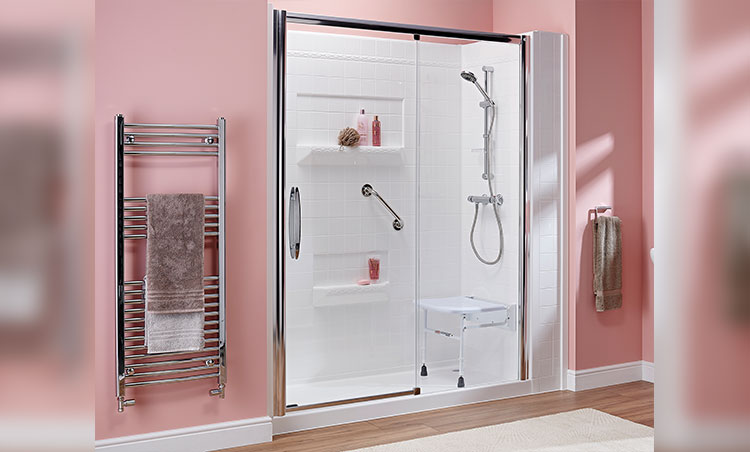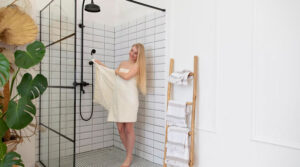Are you tired of the traditional bathroom setup and looking for a modern upgrade? Consider a walk-in shower! Walk-in showers are one of the most popular trends in bathroom design, providing a sleek and contemporary look while being functional and space-saving. In this article, we will guide you through everything you need about walk-in showers, from design ideas to installation tips, and help you make the right choice for your bathroom renovation.
What are Walk-in Showers?
A walk-in shower is an open shower space with no doors or curtains; you can walk into it directly. It is usually tiled and flush with the bathroom floor, making it easy to access without any steps or barriers. Walk-in showers can be customized to fit any bathroom size and shape, making them a popular choice for modern bathroom designs.
Advantages of Walk-in Showers
- They offer a sleek and modern look, making them an excellent choice for contemporary bathroom designs.
- They are space-saving and can be customized to fit any bathroom size and shape.
- Walk-in showers are accessible for people of all ages and abilities, eliminating the need for steps or barriers.
- They are easy to clean and maintain, as there are no doors or curtains to worry about.
Walk-in Shower Designs
There are several walk-in shower design options, depending on your style and bathroom size. Here are some popular walk-in shower designs to consider:
- Doorless Walk-in Showers: Doorless walk-in showers are a popular option for modern bathroom designs. They are easy to access, spacious, and provide a sleek and contemporary look. Without doors or curtains, doorless walk-in showers offer a seamless transition between the shower area and the bathroom, creating an open and airy feel.
- Glass Walk-in Showers: Glass walk-in showers are another popular design option that provides a sense of luxury and elegance. They offer a transparent and reflective surface that adds depth and dimension to your bathroom while providing an unobstructed view of the shower area. Glass walk-in showers are ideal for small bathrooms as they make space look bigger and brighter.
Walk-in Shower Designs
There are several walk-in shower design options, depending on your style and bathroom size. Here are some popular walk-in shower designs to consider:
- Doorless Walk-in Showers: Doorless walk-in showers are a popular option for modern bathroom designs. They are easy to access, spacious, and provide a sleek and contemporary look. Without doors or curtains, doorless walk-in showers offer a seamless transition between the shower area and the bathroom, creating an open and airy feel.
- Glass Walk-in Showers: Glass walk-in showers are another popular design option that provides a sense of luxury and elegance. They offer a transparent and reflective surface that adds depth and dimension to your bathroom while providing an unobstructed view of the shower area. Glass walk-in showers are ideal for small bathrooms as they make space look bigger and brighter.
- Tiled Walk-in Showers: Tiled walk-in showers are a classic and timeless option that can suit any bathroom style. They offer endless design options, from colourful mosaics to neutral subway tiles, and can create a cohesive look with the rest of your bathroom design. Tiled walk-in showers are also durable, water-resistant, and easy to clean.
- Spa-style Walk-in Showers: Spa-style walk-in showers are designed to create a relaxing and rejuvenating experience in your own home. They typically feature multiple showerheads, built-in benches, and steam options, providing a luxurious and spa-like experience in your bathroom.
Walk-in Shower Enclosures
While walk-in showers don't have doors or curtains, you can still enclose them for added privacy and functionality. Here are some popular walk-in shower enclosure options:
- Half-walls: Half-walls are a popular enclosure option for walk-in showers, providing privacy while maintaining an open and airy feel. They are usually made of glass or tile and can be customized to match the rest of your bathroom design.
Full-glass Enclosures and Walk-in Shower Materials
Full-glass enclosures provide complete privacy while still maintaining a modern and open feel. They are made of thick tempered Glass and can be customized to fit any bathroom size and shape. In addition, full-glass enclosures are easy to clean and maintain, making them a popular choice for busy homeowners.
Custom Enclosures
Consider a custom enclosure if you have a unique bathroom layout or want to add a personal touch to your walk-in shower. You can work with a professional to design an enclosure that suits your style and needs, whether it's a combination of Glass and tile or a curved shape to fit a tight corner.
Walk-in Shower Materials
When it comes to walk-in shower materials, you have several options, depending on your style and budget. Here are some popular walk-in shower materials:
- Tile is a classic and durable option for walk-in shower walls and floors. It comes in a wide range of colours and patterns, making it easy to match your bathroom design. The tile is water-resistant and easy to clean, ideal for high-traffic areas like the shower.
- Glass is a luxurious and modern option for walk-in shower walls and enclosures. It provides a sleek and reflective surface that adds depth and dimension to your bathroom design. Glass is also easy to clean and maintain, making it ideal for busy homeowners.
- Stone is a natural and earthy option for walk-in shower walls and floors. It comes in various textures and colours, from smooth marble to rough-hewn granite, and can create a spa-like atmosphere in your bathroom. Stone is also durable and water-resistant, making it ideal for the shower.
Walk-in Shower Installation
Installing a walk-in shower requires careful planning and preparation to ensure a seamless and functional design. Here are some installation tips to consider:
Hire a Professional
Unless you have experience in plumbing and construction, it's best to hire a professional to install your walk-in shower. They can ensure the plumbing is properly installed, the tiles are level and secure, and the showerhead and drain are correctly positioned.
Plan for Drainage
Walk-in showers require proper drainage to prevent water damage and mould growth. Make sure your shower is installed with a slope to direct water towards the drain and that the drain is adequately positioned and sealed.
Consider Waterproofing
To prevent water damage and leaks, it's vital to waterproof your walk-in shower walls and floors. You can use a waterproofing membrane, cement board, or paint to protect your bathroom from moisture.
Walk-in Shower Plumbing
Proper plumbing is essential for a functional and efficient walk-in shower. Here are some plumbing considerations to keep in mind:
- Water Pressure - Ensure your water pressure is strong enough to provide a comfortable and efficient shower experience. You may need to install a pressure regulator or upgrade your plumbing to ensure adequate water flow.
- Showerhead Placement - The placement of your showerhead can affect the overall functionality and comfort of your walk-in shower. Consider installing multiple showerheads, adjustable heights, or handheld options to customize your shower experience.
- Drain Location - The location of your drain can affect the slope and layout of your walk-in shower. Ensure your drain is positioned in the centre of the shower and the slope is directed towards it to prevent water damage.
Walk-in Shower Lighting
Lighting is an important factor in creating a functional and comfortable walk-in shower. Here are some lighting options to consider:
- Recessed Lighting - Recessed lighting provides a sleek and modern look while providing ample light for your walk-in shower. They can be installed in the ceiling or walls and come in a variety of sizes and styles.
Plan for Drainage
Walk-in showers require proper drainage to prevent water damage and mould growth. Make sure your shower is installed with a slope to direct water towards the drain and that the drain is adequately positioned and sealed.
Consider Waterproofing
To prevent water damage and leaks, it's vital to waterproof your walk-in shower walls and floors. You can use a waterproofing membrane, cement board, or paint to protect your bathroom from moisture.
Walk-in Shower Plumbing
Proper plumbing is essential for a functional and efficient walk-in shower. Here are some plumbing considerations to keep in mind:
- Water Pressure - Ensure your water pressure is strong enough to provide a comfortable and efficient shower experience. You may need to install a pressure regulator or upgrade your plumbing to ensure adequate water flow.
- Showerhead Placement - The placement of your showerhead can affect the overall functionality and comfort of your walk-in shower. Consider installing multiple showerheads, adjustable heights, or handheld options to customize your shower experience.
- Drain Location - The location of your drain can affect the slope and layout of your walk-in shower. Ensure your drain is positioned in the centre of the shower and the slope is directed towards it to prevent water damage.
Walk-in Shower Lighting
Lighting is an important factor in creating a functional and comfortable walk-in shower. Here are some lighting options to consider:
- Recessed Lighting - Recessed lighting provides a sleek and modern look while providing ample light for your walk-in shower. They can be installed in the ceiling or walls and come in a variety of sizes and styles.
- LED Lighting - LED lighting is a popular and energy-efficient option for walk-in shower lighting. It provides bright and customizable light options and can be installed in a variety of locations, including showerheads, niches, and walls.
- Natural Lighting - If you have a window in your bathroom, consider using natural light to brighten up your walk-in shower. You can install frosted Glass or a privacy film to maintain your privacy while still enjoying the benefits of natural light.
Walk-in Shower Maintenance
Maintaining your walk-in shower is essential to keeping it looking and functioning like new. Here are some maintenance tips to consider:
- Clean Regularly - Regularly cleaning your walk-in shower walls and floors is important to prevent mold and mildew growth and maintain a clean and polished look. Use a non-abrasive cleaner and soft brush or sponge to avoid scratching the surface.
- Seal Grout - Grout is the material that fills the gaps between tiles and can be prone to cracking and discoloration. Sealing your grout can help prevent water damage and keep your walk-in shower looking new.
- Repair Damage - If your walk-in shower walls or floors become damaged, it's important to repair them as soon as possible to prevent further damage and maintain the integrity of your shower. Contact a professional for repairs or consider a DIY solution with a repair kit.
Conclusion
Walk-in showers are a popular and luxurious addition to any bathroom. From custom enclosures to full-glass enclosures, there are a variety of options to fit any style and budget. Proper installation, plumbing
FAQs - Walk-In Showers
How long does it take to install a walk-in shower?
The installation time for a walk-in shower can vary depending on the design and complexity of the installation. On average, it can take between one and two weeks to install a walk-in shower.
Can a walk-in shower be added to an existing bathroom?
Yes, a walk-in shower can be added to an existing bathroom, but it may require some modifications to the plumbing and layout. Consult with a professional to determine the feasibility of adding a walk-in shower to your bathroom.
Do walk-in showers require more maintenance than traditional showers?
Walk-in showers require regular cleaning and maintenance to prevent mold and mildew growth and keep them looking like new. However, with proper maintenance, they can be easy to clean and maintain.
What materials are best for walk-in shower floors?
Tile, stone, and concrete are popular options for walk-in shower floors as they are water-resistant and durable. Consider slip-resistant options to ensure safety in the shower.





